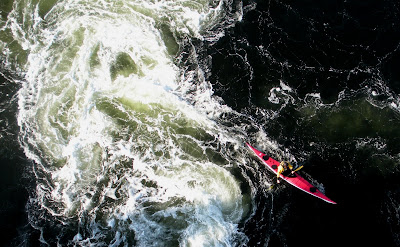29/06/2010Bagh an Da Dhoruis to Loch Gruinart.
Oyster Catchers are better than an alarm clock. Their shrilling call which had been our companion throughout the trip now indicated that it was time to get up. Even before I unzipped the inner tent door I could tell that it was a fine morning. The sea was flat calm, mostly blue sky, the waves broke gently on the beach, Red Deer were feeding on the ridge above the cliffs, Seals floated with their heads pointing skywards (sleeping or just floating?), Ring Plovers trilled, Turnstones twittered. You got the feeling that it was going to be another great day on the water. We would wait for the tide to rise before setting off so this gave us a few hours to explore the beach and coast line again; but first breakfast and lashings of tea.
More Otter tracks on the beach, this time near our tents.

Further on in the week I was talking to the Skipper of the Port Askaig to Jura ferry about the number of Spider Crab shells and limbs that I had found at Bagh an Da Dhoruis (I thought we didn’t get them round the coast of Scotland). He explained how trawlers (didn’t say where from) had been discarding their catch of Spider Crabs north of Islay if they could not get them to market before they died. Since then these spiders have grown in numbers to such an extent that some of the Scallop beds are unfishable. The Spiders that are caught by the Lobster/Crab fishermen (due to their size) are taken from the outside of the pots as they cling onto the netting.I was going to assemble one together from the many parts lying about the beach, but I was not sure how many legs they have or what direction the legs should be placed in.
Spider Crab

Arctic Tern nest and eggs.

Beachcombing is one of my favourite activities when kayaking. Bagh an Da Dhoruis being a storm beach was ideal. Buoys and rope from fishing activities were sprinkled along the high water mark pushed up with the storms. Lobster pots, a few new but most in varying states of decay also held my interest. Wood that had been sculptured by the sea, sun and sand is always beautiful to look, also useful for firewood. However, in the caves near the sea there is plenty of evidence of the problem that plastics/plastic containers can have on this environment. This last comment does not take away anything from the beauty of this area. Time to leave Bagh an Da Dhoruis and head along the rugged but beautiful shoreline. Just as the Seals had escorted us into Bagh an Da Dhoruis, they also escorted us out. The cliffs west from Bagh an Da Dhoruis are a testament to the battle that rages between sea and land. Which element is winning this battle is highlighted by the numerous numbers of caves, arches and collapsed arches that are littered for miles along the coast. The scale of some of these features were only conveyed by Fulmars flying from them or nesting on the otter cave or arch walls. Every rock cove, stony beach or sculpture rock formation seems to invite you to explore the area more closely. It would take a full week or more to explore this area fully. The rocky out crop at Rubha Bholsa held some of the largest colonies of seals we had observed.



Looking southwest down the coast towards Ardnave Point we could see that the landscape would soon be changing.
We decided to explore one last beach near Gortantaoid Point.
 Saturday saw us heading into Oban for supplies and the moorings at Dunstaffnage demanded a few pictures.
Saturday saw us heading into Oban for supplies and the moorings at Dunstaffnage demanded a few pictures. Connel Bridge and the Falls of Lora on an ebb tide.
Connel Bridge and the Falls of Lora on an ebb tide. Kayakers: sea and river/surf are always attracted to the Fall of Lora at spring tides.
Kayakers: sea and river/surf are always attracted to the Fall of Lora at spring tides. The view up Loch Etive from the Connel Bridge.
The view up Loch Etive from the Connel Bridge.
 Sea Kayakers enjoying the ebb flow from Loch Etive.
Sea Kayakers enjoying the ebb flow from Loch Etive.


 River/surf kayakers demonstrating their skills on the big wave at the north end of the Connel Bridge.
River/surf kayakers demonstrating their skills on the big wave at the north end of the Connel Bridge.


 Most of the time was was taken up by reading, eating and sitting in the sun, enjoying the natural environment. The changing colours on the trees and surrounding vegetation was a pleasure to the eye and soul. The most energetic day was a short trip up to the village of Port Appin, where we walked and were again rewarded by the beautiful surroundings and veiws.
Most of the time was was taken up by reading, eating and sitting in the sun, enjoying the natural environment. The changing colours on the trees and surrounding vegetation was a pleasure to the eye and soul. The most energetic day was a short trip up to the village of Port Appin, where we walked and were again rewarded by the beautiful surroundings and veiws. 




.JPG)
 Our final day on the water was enjoyable as the weather was fine. We headed through
Our final day on the water was enjoyable as the weather was fine. We headed through 









 Hope you enjoyed.
Hope you enjoyed. 




.JPG)



















.JPG)

